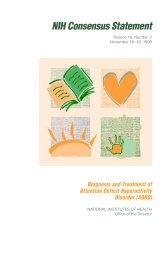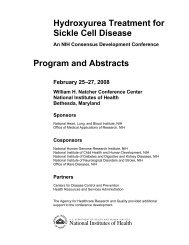What Are the Sensitivity and Specificity ofSerological Tests for <strong>Celiac</strong> <strong>Disease</strong>? Do Sensitivity and Specificity Vary in Different Populations? Ivor D. Hill, M.D.Clinical practice serological tests for celiac disease (CD) are useful for identifyingindividuals who require an intestinal biopsy to diagnose the condition, are supportive of thediagnosis in those with characteristic small intestinal histological changes, and may be used tomonitor response to treatment. Tests most commonly offered by commercial laboratories includeIgG- and IgA-based antigliadin antibodies (AGA-IgG and AGA-IgA), IgA endomysiumantibody (EMA-IgA), IgA tissue transglutaminase antibody (TTG-IgA), and IgA antireticulinantibody (ARA-IgA).The sensitivity and specificity of these tests have been studied largely in research settingsand their accuracy may not be as good in clinical practice. Reasons for this include (1) lack oftest standardization between laboratories; (2) problems defining a “gold standard” for diagnosingCD; and (3) study populations in the research settings usually differ from those in clinicalpractice. The sensitivity and specificity for each test are illustrated in table 1. These values arebased on studies comparing patients with biopsy-confirmed CD to those with normal smallintestinal histology and/or disease controls.Table 1. Sensitivity and Specificity of Individual Serological TestsTest Age Group Sensitivity SpecificityAGA-IgG Adults/Combined* (1,4,5,11)57–100%Children (2,3,7–10,12) 88–100%AGA-IgA Adults/Combined (1,4,6,14,18)54–100%Children (2,3,7–10,12,13,15–17) 52–100%69–87%47–94%79–100%71–100%EMA Adults (5,17,25,27,28) 87–95% 95–100%Children (2,8,9,15,17,19,24,25) 88–100% 90–100%Combined (1,4,20–23,26) 91–98% 99–100%TTG Children (19,25,33,34) 90–100% 94–100%Combined (20–32) 84–100% 91–100%ARA Children (7,8,36) 65–94% 93–100%*Combined—refers to studies involving both adults and childrenBoth sensitivity and specificity for AGA tests are highly variable. In general, AGA-IgGin children has good sensitivity but poor specificity. Adult data is less reliable due to therelatively small number of studies in this age group. Sensitivity of AGA-IgA is lower than that27
for the IgG-based test, while specificity is higher. Based on a small number of studies, sensitivityand specificity for AGA can be improved using a combination of the IgG and IgA tests.EMA-IgA is both highly sensitive and specific. Most studies demonstrate EMAsensitivities in excess of 94 percent in children and 90 percent in adults with specificities above97 percent in both age groups. Studies comparing the use of human umbilical cord with monkeyesophagus as substrate for the EMA tests show no difference in their performance values.TTG-IgA is also highly sensitive and specific. Initial studies on TTG used guinea pigprotein as antigen while most recent studies have used human recombinant protein. In twocomparative studies, human-derived assays were shown to have improved sensitivity andspecificity over guinea pig-derived tests. (26,35) One study found TTG-IgA by RIA to be moresensitive than by ELISA but with identical specificity. (19) In general, TTG-IgA and EMA-IgAtests have similar sensitivity and specificity.ARA-IgA is less frequently used in clinical practice and fewer studies are available toassess the sensitivity and specificity of this test. One study demonstrated a sensitivity of only64 percent (8) while others have found higher figures (table 1).Selective IgA deficiency is more common in individuals with CD and occurs inapproximately 2 percent of those with the condition. IgA-based tests for AGA, EMA, and TTGare unable to identify individuals with IgA deficiency who require a biopsy to diagnose CD.AGA-IgG tests are most often used for this purpose but are poorly predictive for positivehistological findings. (37,38) IgG-based tests for EMA and TTG may be more accurate foridentifying symptomatic individuals with CD. Sensitivity and specificity of TTG-IgG innon-IgA-deficient individuals with CD range from 84–97 percent and 91–93 percent,respectively. (39–41) There was good concordance between TTG-IgG and EMA-IgG in one study. (39)Good comparative studies on the sensitivity and specificity of the serological tests indifferent ethnic populations are not available. A few studies have compared results betweenchildren and adults. One study suggested AGA tests were better for identifying children under 5years of age while EMA-IgA were better for those over 5 years of age. (1) Similarly, sensitivityand specificity for TTG-IgA was higher for adults (95 percent and 100 percent) than children(93 percent and 97 percent). (25) It is also possible that EMA-IgA is less reliable in children under2 years of age. (2)SummaryTTG-IgA (human recombinant) and EMA-IgA are the most sensitive and specificserological tests available for identifying individuals who require an intestinal biopsy for CDdiagnosis. Their accuracy in clinical practice may not be as good as that reported from theresearch setting. Therefore, a positive diagnosis of CD should not be made on the basis of aserological test alone without intestinal biopsy confirmation. Serological tests may be lessreliable in very young children. AGA tests are no longer recommended as a screening testbecause of the variable sensitivity and specificity associated with this test. There is no advantageto using a panel of tests incorporating AGA, EMA, and TTG antibodies over a single test usingEMA or TTG.28
- Page 1 and 2: NIH Consensus Development Conferenc
- Page 3 and 4: III. What Are the Manifestations an
- Page 5 and 6: • What is the management of celia
- Page 7 and 8: Monday, June 28, 2004 (continued)I.
- Page 9 and 10: Monday, June 28, 2004 (continued)II
- Page 11 and 12: Wednesday, June 30, 2004 (continued
- Page 13 and 14: Lisa H. RichardsonConsumer Represen
- Page 15 and 16: Ciaran P. Kelly, M.D.Director, Celi
- Page 17 and 18: Van S. Hubbard, M.D., Ph.D.Director
- Page 19 and 20: AbstractsThe following are abstract
- Page 21 and 22: susceptibility (e.g., DR17 homozygo
- Page 23 and 24: The Pathology of Celiac DiseaseDavi
- Page 25: In this regard, the transport pathw
- Page 29 and 30: 15. de Lecea A, Ribes-Koninckx C, P
- Page 31 and 32: Clinical Algorithm in Celiac Diseas
- Page 33 and 34: Considera diagnosisof celiac diseas
- Page 35 and 36: There are populations at particular
- Page 37 and 38: Serological Testing for Celiac Dise
- Page 39 and 40: Estimates of the sensitivity of the
- Page 41 and 42: the risk and severity of CD may als
- Page 43 and 44: What Are the Prevalence and Inciden
- Page 45 and 46: ascribed to excess menstrual loss.
- Page 47 and 48: ReferencesFamily History of Celiac
- Page 49 and 50: Carroccio A, Iannitto E, Cavataio F
- Page 51 and 52: identified by surveys or through so
- Page 53 and 54: Clinical Presentation of Celiac Dis
- Page 55 and 56: een widely reported. The question r
- Page 57 and 58: The Many Faces of Celiac Disease: C
- Page 59 and 60: References1. Green PH, Jabri B. Coe
- Page 61 and 62: Association of Celiac Disease and G
- Page 63 and 64: Does the Gluten-Free Diet Protect F
- Page 65 and 66: Skin Manifestations of Celiac Disea
- Page 67 and 68: allow a better understanding of the
- Page 69 and 70: 4. Henriksson KG, Hallert C, Walan
- Page 71 and 72: characterized, clinically-identifie
- Page 73 and 74: 10. Hoffenberg EJ, Emery LM, Barrig
- Page 75 and 76: ataxia, epilepsy with posterior cer
- Page 77 and 78:
Consequences of Testing for Celiac
- Page 79 and 80:
Osteoporosis/FracturesThere were 11
- Page 81 and 82:
Dietary Guidelines for Celiac Disea
- Page 85 and 86:
21. Thompson T. Thiamin, riboflavin
- Page 88 and 89:
In order to effectively counsel ind
- Page 90 and 91:
9. Hallert C, Granno C, Hulten S, M
- Page 92 and 93:
adhered to the GFD after more than
- Page 94 and 95:
Patient education, close supervisio
- Page 96:
26. Mustalahti K, Lohiniemi S, Laip







